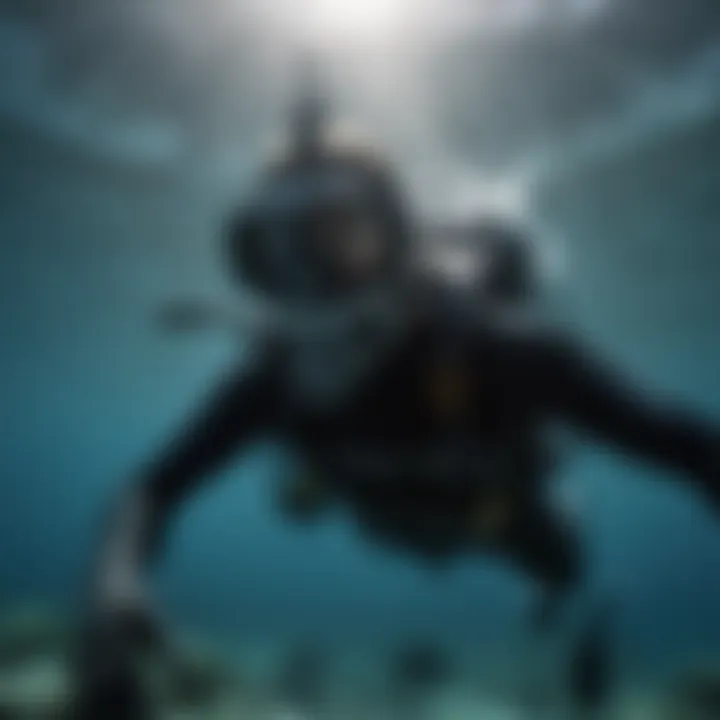Exploring Shark Shield Technology in Extreme Sports


Intro
Shark Shield technology represents a significant advancement in ensuring safety for water sports participants. Extreme sports, particularly those involving the ocean, often carry inherent risks, with shark encounters being one of the more alarming concerns. The introduction of Shark Shield devices aims to alleviate some of this anxiety among athletes and enthusiasts. This section will provide essential context around extreme sports, spotlighting their unique characteristics as well as the importance of safety measures.
Extreme Sports Overview
Definition of Extreme Sports
Extreme sports refer to activities characterized by a high degree of risk and adrenaline, involving speed, height, and physical exertion in unpredictable environments. These sports attract thrill-seekers looking for an immersive experience where traditional safety measures may be challenged. Participants often push their limits, embracing extreme conditions and the possibility of injury.
History and Evolution
Extreme sports have roots dating back several decades. In the mid-20th century, sports like surfing and skateboarding gained popularity, evolving into recognized subcultures. As technology and media advanced, more extreme activities emerged, such as base jumping and snowboarding. Over time, the extreme sports landscape broadened, with an increase in participation and commercialization, enhancing the need for technologies like Shark Shield to mitigate risks.
Popular Extreme Sports Disciplines
Several disciplines are synonymous with extreme sports, each boasting a distinct appeal:
- Surfing: Riding waves with skill and balance, often in ocean waters known for varying conditions.
- Kitesurfing: Combining surfing and paragliding for an exhilarating experience on water surfaces.
- Diving: Exploring underwater realms, which, while beautiful, can be unpredictable, especially in shark-prone areas.
- Mountain Biking: Traversing challenging terrains, where crashes can lead to serious injuries if proper gear is not used.
- Wakeboarding: A water sport involving riding on a board while being towed by a boat, also facing risks associated with aquatic terrains.
Gear and Equipment
Essential Gear for Different Sports
Safety equipment is crucial in extreme sports to minimize risks. Depending on the sport, specific gear is essential:
- For Surfing: A quality wetsuit, surfboard, and safety leg ropes.
- For Kitesurfing: Harness, kites, and helmets.
- For Diving: Wetsuits, tanks, and dive computers.
- For Mountain Biking: Helmets, elbow and knee pads, and gloves.
- For Wakeboarding: Life jackets, boards, and bindings.
Gear Reviews and Comparisons
Evaluating gear involves looking at durability, comfort and safety ratings. Advanced gear often includes features that enhance safety. For example, a high-quality wetsuit in surfing can provide thermal protection while enabling mobility.
Safety Ratings and Certifications
Understanding safety ratings ensures that athletes choose reliable equipment. Various standards exist, informing users about the effectiveness and durability of the gear.
Training and Preparation
Physical Conditioning and Fitness Tips
Athletes in extreme sports must maintain optimal physical fitness. Regular conditioning helps in increasing stamina, strength, and flexibility, which are vital to perform effectively and safely.
Mental Preparation Techniques
Mental conditioning is as important as physical training. Athletes often practice visualization techniques to enhance performance. This mental aspect prepares their minds for unpredictable situations that may arise.
Training Regimens for Various Sports
Structured training regimens tailored to each sport can improve performance. For instance, surfers might combine swimming with aerobic workouts, while mountain bikers focus on leg and core strength.
Locations and Destinations
Top Destinations for Extreme Sports
Understanding the best locations can enhance the overall experience. Popular spots include:
- Hawaii: Renowned for its legendary surfing waves.
- California: Offers diverse opportunities for kitesurfing, biking, and skating.
- Australia: Known for world-class diving locations and shark encounters
Travel Tips and Guides
Traveling to engage in extreme sports demands careful planning. Athletes should research local regulations, required permits, and safety guidelines. Additionally, it's advised to learn about local wildlife, particularly when engaging in water sports.
Culmination
In summary, Shark Shield technology highlights essential safety advancements within the extreme sports arena. As athletes continue to seek thrills, innovations that protect against risks only enhance the overall experience. Understanding the intersection of adventure and safety enriches one's engagement with these thrilling activities.
Understanding Shark Shield Technology


Shark Shield technology plays a crucial role in enhancing safety for individuals engaged in extreme sports activities in the ocean. This technology is especially valuable in environments where encounters with sharks can pose significant risks. Understanding the principles and operations of Shark Shield devices is vital not only for safety but also for training and increasing awareness among sports enthusiasts.
The devices work by creating an electromagnetic field that is unpleasant for sharks, thereby encouraging them to steer away from areas where these devices are deployed. This function is critical for surfers, divers, and kayakers, allowing them to participate in their sports with a higher degree of confidence.
Moreover, comprehending the technology behind Shark Shield allows users to make informed choices regarding its application, maintenance, and integration into their safety protocols. As extreme sports continue to gain popularity, the relevance of such safety measures cannot be understated.
Defining Shark Shield Technology
Shark Shield technology refers to a specific application of electromagnetic fields designed to deter sharks. These devices can be worn or attached to boards, kayaks, and various diving equipment. By producing a unique electromagnetic signature, these technologies exploit sharks' natural sensitivity to electric fields, effectively creating a protective barrier for users engaged in aquatic activities.
The primary goal of Shark Shield technology is to minimize shark attacks and redefine what it means to be safe in large waters. With innovation at its core, this technology represents a fusion of engineering, marine biology, and practical safety measures.
The Science of Electromagnetic Fields
Understanding how electromagnetic fields work is essential to grasping the operation of Shark Shield technology. These fields are invisible and are generated by electric current, which interacts with the body's natural electric signature. In extreme sports settings, this forms the basis of how athletes can protect themselves.
Basic principles of electromagnetic deterrence
The principle behind electromagnetic deterrence is relatively straightforward. Sharks possess specialized sensory organs, known as the ampullae of Lorenzini, that allow them to detect electric fields in water. Shark Shield devices create a distinct electromagnetic field that disrupts these signals.
This is why electromagnetic deterrence is effective; it is based on a shark's natural responses to these signals. Not only is this technology designed to repel sharks, but it also operates without causing them any harm, making it a responsible choice for aquatic safety.
How sharks perceive electromagnetic fields
Sharks are unique in their ability to sense minute changes in electromagnetic fields, a trait that sets them apart in the animal kingdom. Their perception of these fields is not just a minor adaptation; it is vital for their hunting and navigation. When Shark Shield technology is deployed, it triggers a reaction in sharks, causing them to change their path and avoid the area.
This natural behavior is critical to the technology's effectiveness. By understanding how sharks perceive electromagnetic fields, we see the innovation is grounded in biological mechanics rather than a superficial solution. This reliability enhances the appeal of Shark Shield devices among extreme sports enthusiasts who want aggressive safety measures.
Components of Shark Shield Devices
Shark Shield devices are composed of several essential elements that contribute to their overall effectiveness and usability. Knowing these components can aid users in selecting and utilizing technology that best matches their sport and preferences.
Design features that enhance usability
The overarching design of Shark Shield devices emphasizes user-friendly features. These often include lightweight materials, streamlined profiles, and waterproof cases.
These design features cater specifically to people engaged in high-energy activities like surfing and diving, where ease of use can enhance performance. The intuitive interface often makes these devices easy to operate, ensuring that athletes can activate the shields without distraction.
Battery and power considerations
Powering Shark Shield devices is another critical aspect to consider. Most devices use rechargeable battery systems, allowing users to maximize their use while on the water. Understanding battery life and charging options is paramount for users to operate optimally in the field.
Applications in Extreme Sports
Shark Shield technology has gained significant attention for its applications in extreme sports. This focus is primarily due to the necessity of safety in environments where individuals engage in activities like surfing, diving, and kayaking. Each application of the technology not only aims to deter sharks but also ensures that participants feel secure, enabling them to pursue their passions without the looming fear of shark encounters. Addressing this need is essential, as it encourages broader participation in these sports.
Surfing and Shark Shield Technology
User perspectives and testimonials
User perspectives play a crucial role in understanding the real-world effectiveness of Shark Shield technology in surfing. Many surfers have shared their experiences using these devices, highlighting a newfound confidence in the water. The most notable characteristic of these testimonials is the assurance that comes from knowing there is a protective measure in place.
Surfers frequently describe feeling less anxious while riding waves, which contributes positively to their overall enjoyment of the sport. Unique to these testimonials is the detailed accounts of specific instances where surfers felt a device may have prevented a potential shark encounter. While there may be anecdotal evidence, the personal stories add depth to the understanding of Shark Shield's actual impact in surfing environments.
Recent trends in surf competitions
The integration of Shark Shield technology into surf competitions has become increasingly prominent. This trend reflects a growing recognition of safety among surfers at all levels of competition. Many events now encourage the use of these devices, which aligns with the aim of promoting athlete safety.
A key characteristic of these trends is the proactive approach to shark deterrence, where competition organizers recognize that safety can enhance performance. Surprisingly, some competitions have included Shark Shield in their safety protocols. This feature serves as a strong statement about the relevance of safety in extreme sports. However, there are also discussions regarding the possible consequences of relying on technology alone. Critics point out that while Shark Shields can help, they do not replace the need for constant vigilance in the water.
Diving Adventures and Safety
Use cases among divers
When it comes to diving, the use of Shark Shield devices is becoming more common. Divers report a range of experiences that underscore the device's benefits. The primary characteristic of these use cases is the added layer of protection while exploring underwater ecosystems. Divers appreciate that Shark Shields can act as a deterrent, thus reducing the likelihood of shark interactions.
Distinctly, some dive schools have adopted these devices for group dives, showcasing a commitment to diver safety. The use cases illustrate not only individual safety but also a collective responsibility in dive tourism. Nevertheless, while effective, there remains some skepticism about the overall reliability of the devices in unpredictable underwater environments.
Impact on dive tourism


The adoption of Shark Shield technology has influenced dive tourism significantly. Tour operators often promote the safety measures in place, which includes the use of Shark Shields. This emphasis has contributed to a more secure atmosphere for both newcomers and experienced divers. As a result, many divers feel encouraged to engage in deeper and more thrilling dives.
A particularly advantageous aspect is the enhancement of customer confidence. With the assurance that an effective deterrent is present, operators have noted an increase in bookings and interest in diving experiences. However, some dive instructors mention a risk of complacency. They emphasize that while technology plays a crucial role, divers must still exercise caution and not solely rely on the devices to prevent encounters.
Kayaking and Coastal Exploration
Adaptations for kayaking environments
In the context of kayaking, Shark Shield technology is adapted to meet the specific conditions faced by paddlers. These adaptations include waterproof cases for the devices and modifications to fit various kayak designs. A unique aspect of these innovations is that they allow devices to be functional without compromising the kayak's performance or stability.
Kayakers have found that such adaptations provide added peace of mind. Enhanced models are now widely available and are actively marketed by manufacturers. However, kayakers must be aware that the effectiveness of these devices may vary based on water conditions and surroundings.
Safety protocols for paddlers
Implementing safety protocols for paddlers is vital when employing Shark Shield devices. These protocols often involve guidelines on how and when to use the devices effectively during excursions. A key characteristic of these protocols is the need for education among kayakers about the functionality of the devices. Understanding these guidelines ensures that paddlers do not become overly reliant on technology.
Unique to this approach is the collaborative effort between kayak manufacturers and safety organizations to promote best practices. Through workshops and informational sessions, paddlers can learn about proper usage and the importance of remaining vigilant in shark-prone waters. While these protocols enhance safety, the effectiveness ultimately relies on the user's understanding and application in real-life situations.
Evaluating Effectiveness
Understanding the effectiveness of Shark Shield technology is crucial for enthusiasts and athletes involved in water sports. Effective evaluation allows for better decision-making regarding safety measures. This section explores key scientific studies, user experiences, and various factors that influence the perceived effectiveness of Shark Shield devices. An effective understanding can help bridge the gap between anecdotal evidence and empirical research, providing a clearer view of the technology's real-world applications.
Scientific Studies and Findings
Key research on deterrence rates
Research studies focusing on deterrence rates provide insight into how well Shark Shield technology performs in real environments. Various studies have aimed to measure the device's ability to deter sharks effectively. A significant characteristic of this body of research is its emphasis on environmental variables that can impact outcomes. Understanding these factors is beneficial when assessing the technology's overall efficacy.
One unique feature of this research is its reliance on field tests rather than theoretical models. This approach offers advantages, such as providing data in realistic scenarios. However, limitations may arise from varied methodologies across studies.
Limitations of current research
While existing research has yielded valuable insights, several limitations exist. A key characteristic of current studies is the diversity in their experimental designs, which can lead to inconsistencies. This diversity raises questions about the generalizability of results. This aspect continues to be relevant as more comprehensive approaches, such as meta-analyses, are needed to strengthen findings.
A unique concern is that many studies do not take into account the long-term effects of regular use of Shark Shield devices. Understanding the potential drawbacks or negative consequences is crucial. Therefore, while research has laid a foundation, further investigations are essential to solidify claims about effectiveness.
User Experiences and Anecdotes
Case studies from extreme sports users
Real-world case studies highlight user experiences with Shark Shield technology in extreme sports contexts. According to reports from athletes, these anecdotes provide contextual understanding that quantitative studies might overlook. A key characteristic of these personal narratives is their relatability and emotional context.
The unique feature of these case studies is the detailed accounts they offer regarding specific incidents involving shark encounters. These narratives can be beneficial for readers by presenting a more nuanced view of the effectiveness of Shark Shield. However, some experiences may be anecdotal, lacking scientific rigor, thus requiring a critical view.
Comparative experiences without Shark Shield
Examining situations where no deterrent is present contributes to understanding Shark Shield's value. Anecdotes from users who experienced shark interactions without the technology reveal stark contrasts. A critical characteristic of these comparative accounts lies in their emphasis on personal safety. Many users describe heightened anxiety and concern when venturing into waters without protection.
Distinctively, these experiences provide a baseline measure for evaluating the Shark Shield's functionality. Observations of fear levels, incidents reported, and behavioral changes contribute depth to the analysis. However, relying exclusively on user testimonies presents challenges. There is the potential for bias, which can skew perceptions about the necessity and effectiveness of using the technology.
Ultimately, both research findings and user experiences play a vital role in evaluating Shark Shield's effectiveness. Careful analysis of these elements provides a broader understanding of the technology's impact on safety in extreme sports.
Future Directions of Shark Shield Technology
The future of Shark Shield technology shows promise for further advancements and broader applications. As we look ahead, understanding the innovation and potential use cases is critical for both enthusiasts and researchers. Enhancements in the technology can lead to improved effectiveness and integration into various fields, emphasizing the importance of safety measures in extreme water sports and beyond.
Innovations on the Horizon
Advancements in electromagnetic technology
The field of electromagnetic technology has been evolving, and it is significant for Shark Shield devices. Improved electromagnetic frequencies can create a more effective barrier against sharks. This can lead to not only higher deterrence rates but also increased overall safety for users in extreme sports.
A key characteristic of this advancement is the ongoing research to refine the frequencies used. As scientists develop new methods to generate previously unexplored electromagnetic fields, the potential for a highly effective deterrent becomes more realistic.
Unique features such as adjustable frequencies or enhanced power output can provide distinct advantages. These may result in devices that are not only lighter and more portable but also adaptable to various environments and user preferences.
Potential for integration with other safety devices


The possibility for integrating Shark Shield technology with other safety devices presents a key area for future development. This synergy could create comprehensive safety solutions for water sports participants. Devices such as personal flotation instruments or advanced monitoring systems could benefit from such integration.
One essential characteristic is the interoperability between devices, ensuring that a swimmer, surfer, or diver can have all safety measures working in concert. This is beneficial because it can provide a holistic approach to user safety, minimizing risks associated with marine activities.
The ability to combine the technology with existing safety measures allows for a unique feature: multi-layered protection. This could greatly enhance the user experience and safety, but the potential complexity might present challenges in terms of usability and maintenance.
Expanding Use Cases
Potential applications in marine research
Shark Shield technology can extend its reach into marine research. This application not only enhances safety for researchers but can also contribute to studying shark behavior and habitats. Through non-intrusive methods, it is possible to observe sharks without disturbing their natural activities.
The primary feature of this application is its potential for non-lethal interaction with marine life. This approach is beneficial as it allows researchers to analyze wildlife behavior in a controlled manner without causing harm.
The possibility of gathering significant data on shark populations and movements could lead to smarter conservation strategies and better environmental practices, allowing the technology to play a vital role in marine sciences.
Use in recreational fishing
In recreational fishing, Shark Shield technology offers potential advantages, particularly concerning user safety. Anglers can fish in areas known for shark activity while minimizing the risks involved. This capability is crucial for anyone willing to venture into more challenging waters.
Key benefits include the lower probability of unwanted encounters with sharks when using such technology. The unique aspect is that recreational fishers can enjoy their activities with a sense of security.
However, challenges may arise from the need for careful management of the technology in different fishing scenarios. Ensuring the compatibility of the devices with various types of fishing gear requires thorough consideration, highlighting the necessity of ongoing research and adaptation.
Ethical Considerations and Environmental Impact
Shark Shield technology, while aimed at enhancing safety in extreme sports, also raises essential concerns about its ethical implications and environmental impact. Understanding these aspects is crucial for athletes, safety experts, and conservationists alike. The use of Shark Shield devices presents both benefits and challenges, particularly in marine ecosystems, which necessitates a balanced approach that prioritizes human safety and environmental sustainability.
Impact on Marine Life
Concerns regarding shark behavior
One critical aspect of concerns regarding shark behavior involves how Sharks may respond to electromagnetic fields created by Shark Shield devices. Electromagnetic deterrence can effectively alter a shark's natural hunting behavior. This alteration could lead to unintended consequences, such as a change in migration patterns and feeding habits, which is essential to their survival. Understanding these shifts gives insight into the broader implications of using such devices in their habitats.
Key characteristics of this concern include the potential for prolonged behavioral changes in shark populations that could disrupt local ecosystems. The consideration here is that while these devices aim to protect humans, they may inadvertently affect shark populations, which are already vulnerable due to overfishing and habitat loss. Therefore, analyzing these changes helps in the development of more refined, environmentally-friendly technologies in the future.
Research on non-target species
Research on non-target species highlights the importance of assessing the broader ecological impact of Shark Shield technology. This aspect examines how devices affect other marine organisms that fall outside the target of the technology. The key characteristic of this research is investigating if the electromagnetic fields from Shark Shields are disruptive to non-target species, like smaller fish or invertebrates. Understanding these relationships can inform effective design and usage of the devices, ensuring that other marine beings remain unharmed.
Unique features of this research include studies that identify potential adverse effects on marine habitats, revealing both advantages and disadvantages of deploying such technology. This ensures a more comprehensive understanding for users, and it also aligns with sustainability goals that seek to minimize human impact on ocean environments.
Balancing Human Safety and Conservation
Guidelines for responsible usage
Guidelines for responsible usage emerge as a necessary framework to align the use of Shark Shield technology with conservation efforts. This aspect promotes a responsible approach among users, emphasizing the need to respect marine environments. By following such guidelines, athletes can enjoy their extreme sports while minimizing the impact on marine life.
The key characteristic of these guidelines includes best practices, such as avoiding sensitive marine areas during critical periods for sharks, like breeding or feeding seasons. The benefit of adhering to these guidelines lies in fostering a culture of conservation among water sports enthusiasts. It equips users with knowledge that leads to informed decisions while using Shark Shield devices.
Collaborative efforts with conservationists
Collaborative efforts with conservationists bridge the gap between technology use and marine conservation. This partnership ensures that the implementation of Shark Shields does not compromise ecological integrity. By engaging with conservationists, manufacturers and users can better understand the ecological nuances involved with the deployment of these devices.
The key characteristic of this collaboration involves shared research initiatives that contribute to an evolving understanding of marine ecosystems. This is vital for keeping Shark Shield technology relevant within the context of environmental stewardship. One unique feature of these efforts includes the development of training programs where users learn about marine ecosystems, thus becoming ambassadors for conservation.
This collaboration presents advantages by embodying a holistic approach that benefits human safety while ensuring marine wildlife remains protected. Overall, these ethical considerations and their environmental impacts must be at the forefront of discussions around Shark Shield technology.
End
The conclusion of this article serves as a vital synthesis of the knowledge presented throughout. Understanding the nuances of Shark Shield technology is crucial for the safety of those who engage in extreme water sports. The insights shared not only highlight the operational mechanisms of the devices but also underscore the significance of user experiences and scientific research.
Summarizing Key Insights
In reviewing the various sections, key insights emerge regarding the efficacy of Shark Shield technology. Users report increased peace of mind while participating in activities such as surfing and diving. The scientific findings affirm that electromagnetic fields can indeed deter sharks, though there are limitations and variables to consider. When evaluating personal experiences alongside academic research, a clearer picture forms about the protective capabilities of these devices.
Future of Shark Shield in Extreme Sports
Continued innovations and safety trends
Looking ahead, there are numerous innovations on the horizon for Shark Shield technology. Manufacturers are continually refining designs to enhance usability and effectiveness. Emerging trends focus on integrating advanced features to cater to diverse extreme sports environments. A key characteristic of these innovations is the focus on user-friendly interfaces, making it easier for athletes to operate the devices efficiently. As technology evolves, these upgrades offer increased reliability during activities. The unique features of these innovations can contribute positively to the overall user experience, providing enhanced safety for adventurers.
Maintaining relevance in extreme sport environments
To maintain relevance, Shark Shield technology must adapt to the changing landscape of extreme sports. This adaptability is crucial as new sports emerge and the popularity of existing ones fluctuates. A central aspect of this responsiveness is the continued collaboration with athletes to develop tailored solutions that meet specific needs. Such partnerships can lead to advancements that resonate well within the extreme sports community. The unique feature of user-driven design ensures that safety devices meet real-world demands, proving advantageous in high-stakes environments. Without this relevance, the devices could potentially fade away in the dynamic world of extreme sports.







